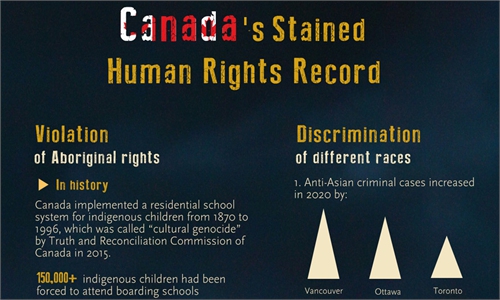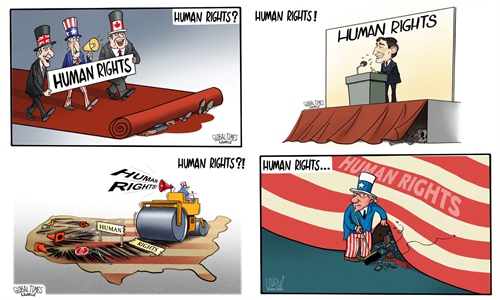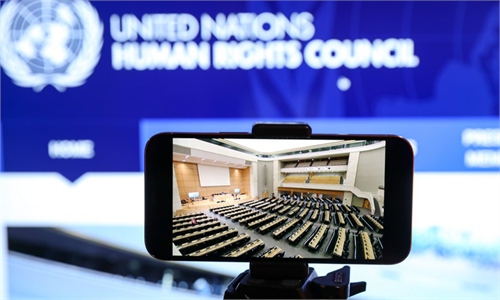IN-DEPTH / IN-DEPTH
Forced and child labor, human trafficking – what else is the US brandishing against others that reflect its own ills?
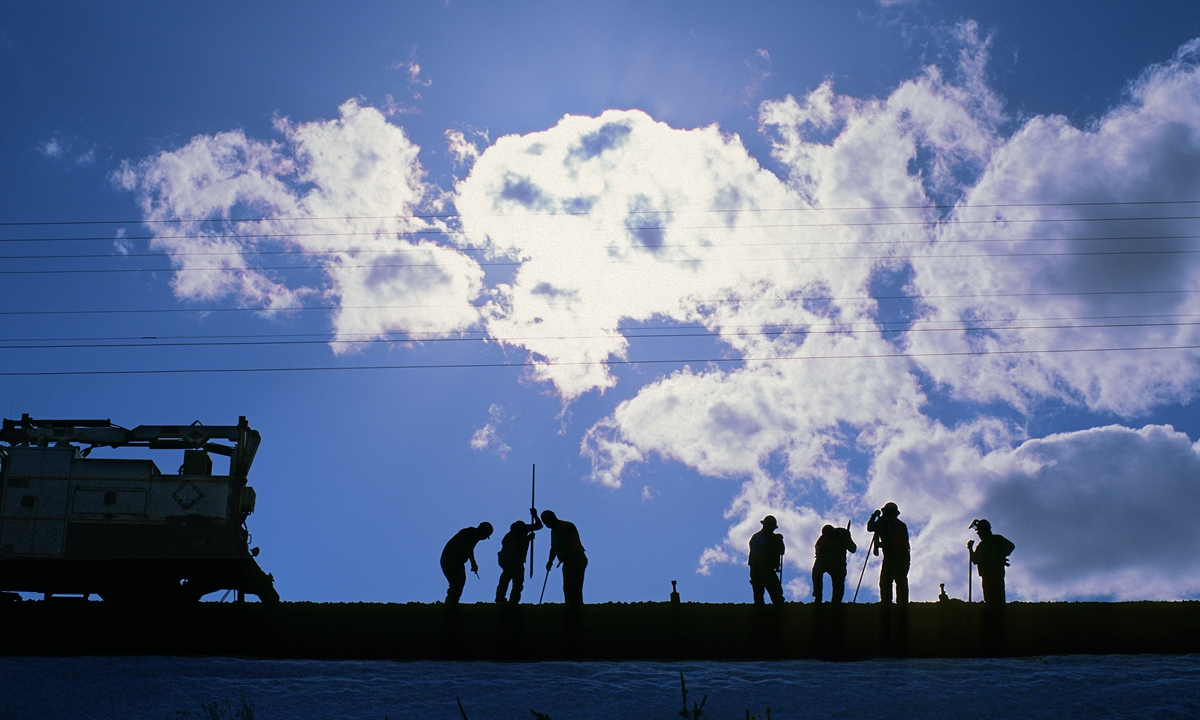
Workers build a railroad in Utah, US. Photo: VCG
The US-led Western countries' hyping of Xinjiang-related topics at the 47th session of the United Nations Human Rights Council was no surprise to the international community, which has long since been bored with their groundless "genocide" or "forced labor" cliches defaming China and its Xinjiang region, observers found.The US, always pointing the finger at China, is infamous for its deplorable human rights record. At the recently ended 109th Session of the International Labor Conference (ILC) in June, the US was widely criticized over the issue of child labor. With approximately 500,000 child farm-workers nationwide, the US is the only country in the world that has not ratified the United Nations Convention on the Rights of the Child (UNCRC), Chinese Foreign Ministry Spokesperson Zhao Lijian pointed out.
Other human rights violations including forced labor and human trafficking are also raging rampant in the US. With long existing racial conflict and social division, America's people of color are the main victims of the US' labor-related problems, human rights experts and local front-line employees told the Global Times.
Over the years, the International Labor Organization (ILO) has repeatedly urged the US government to solve the problem of forced labor, while the US "turns a deaf ear to its own problems and instead slanders other countries," Zhao said at a press conference on June 16.
Playing the "forced labor" card in attacking China clearly reveals the US' double standards and hypocrisy on labor issues, said Li Chang'an, a professor of the Academy of China Open Economy Studies under the University of International Business and Economics.
"On the one hand, the US is busy playing the 'international policeman' role and brandishing the stick of sanctions in the field of labor; on the other hand, it enjoys the great profits brought by the cheap labor it exploits in developing countries and regions and takes it for granted," Li told the Global Times.
Racism-fueled forced labor
Forced labor, labor exploiting, and discrimination in the recruitment and use of the labor force "have always existed in US history," Zhu Ying, deputy director of the National Human Rights Education and Training Base of Southwest University of Political Science and Law, told the Global Times.
In history, numerous slaves in the US were worked in cotton fields and factories; despite higher rates of mechanization in the North, slaves still continued to be used in the South in a bid to compete with the North, Zhu said.
The cruelty of slavery has since evolved into a brand of forced labor in today's US, with the ILO estimating in 2016 that approximately 57,700 people in the US were trapped in modern slavery, forced to toil against their will in sectors including agriculture, manufacturing, and sex trade.
"The struggle of the nonentity to achieve freedom and success would be called the realization of the 'American Dream,' however, the Asian Americans' 'dream' begins at the bottom, which needs us to pay a more painful price and take a more tortuous path in the quest," Tang Enyang, chairman of the Chinese Restaurant Association in Brooklyn Chinatown in New York, told the Global Times.
Tang pointed out that Asian Americans, including those of Chinese descent, have been victims of forced labor for a long time. In the 1870s, a massive Chinese exclusion movement was perpetrated across the US with large numbers of white people going to Chinatown beating, smashing, and looting, leaving many Chinese Americans with no choice but to become domestic servants or masseurs working for the racist white majority at low hourly wages, he said.
"Domestic servants and masseurs have been an undoubtedly marginalized subset of the community. To make matters worse, the lack of strong oversight bodies and legal protection made it easier for employers to exploit workers. They often work day and night to earn low wages without adequate benefits and security," Tang said.
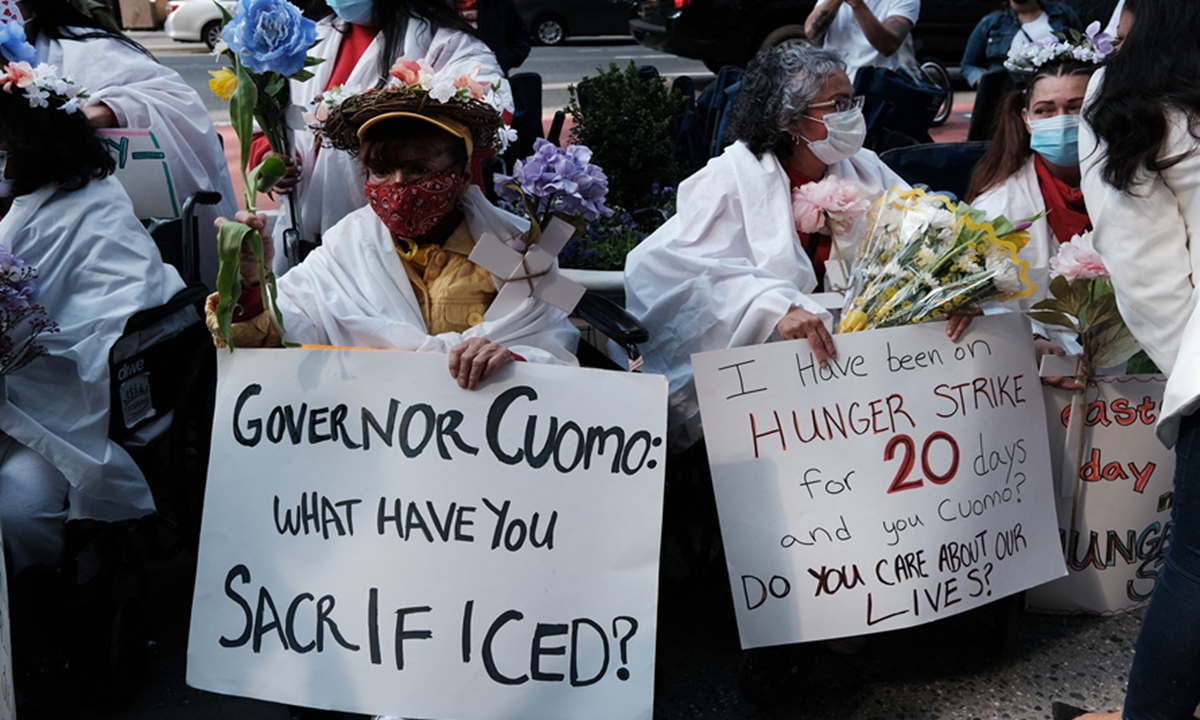
People join a demonstration by workers who are on a 20-day hunger strike on April 4, 2021 in New York, who did not receive federal unemployment aid because of factors like immigration status. Photo: AFP
Many American labor rights groups have criticized the situation that in the US, where domestic workers are excluded from many federal laws protecting workers' rights including the National Labor Relations Act, which limits this group's right to demand higher wages and better health care.US immigration policy also plays an important role in indirectly supporting forced labor, several reports revealed, which requires domestic workers brought to the US by their employers to remain with them or face deportation, leaving workers open to exploitation, as many of them fear reporting abuses committed by their employers.
Tang noted that currently, although the situation for Chinese Americans is improving, there are still many cases of forced labor around him. For example, in the early stage of the COVID-19 outbreak in the US, when all Chinese canteens in Chinatown were closed, some restaurants disregarded the health and wellbeing of their employees, extending the working hours of temporary workers in an attempt to reduce losses, even ordering them not to wear personal protective equipment so as not to scare customers. Some retail employees were fired after calling for stores to be closed to prevent the risk of contracting the virus.
"On any given day, the fruit and vegetables we consume may have been picked by workers in involuntary servitude," Coalition of Immokalee Workers (CIW), a worker-based human rights organization in Florida that launched the Anti-Slavery Program, said on its website.
Through the program, CIW said it has uncovered, investigated, and assisted in the prosecution of numerous multi-state, multi-worker farm slavery operations across the Southeastern US, "helping liberate over 1,200 workers held against their will."
One appalling case in which CIW intervened involved six suspects in Florida accused of making money off of farmworkers from Mexico and Guatemala by forging documents and committing identity theft, CIW revealed on its website. In this case, unpaid workers were forced to sleep in shacks and box trucks and would be beaten if they attempted to escape.
Forced labor also leads to human trafficking tragedies. As many as 100,000 people are reportedly trafficked into the US for forced labor. According to the US government's 2020 Trafficking in Persons Report, human trafficking cases have been reported in all 50 states and the District of Columbia over the past five years. The Federal Bureau of Investigation (FBI) said it recorded 1,883 human trafficking incidents in 2019, some 500 more than that in 2018.
Polaris, a nongovernmental group based in Washington that works to combat and prevent sex and labor trafficking, said the Trafficking Hotline it operates saw a 19 percent increase in 2019 in the number of victims and survivors who directly contacted the group.
Among the victim and survivor records in 2019, Polaris found that when the trafficking began, 1,435 people were adults while 5,359 were minors.
Underage victims
What is even more outrageous is that the US has also extended its grip on the imposition of forced labor on children.
According to US official statistics, in 2019, US law enforcement officers registered 858 cases of child labor in violation of the Fair Labor Standards Act, with a total of 544 minors employed in violation of Hazardous Occupation Orders (HOs).
According to estimates by the US Association of Farmworker Opportunity programs, based on figures gathered by the Department of Labor, there are approximately 500,000 child laborers working in the US. Many children start working at the age of 8, working for up to 72 hours a week, and it is not uncommon for them to work 10 hours or more a day.
The Washington Post reported that between 2003 and 2016, about 452 children died from work-related injuries in the US, including 73 who were aged 12 or younger. And in that same period, 237 children died while working in agriculture, according to the reports by the organizations concerned, indicating that more US child workers die in agriculture than in any other industry.
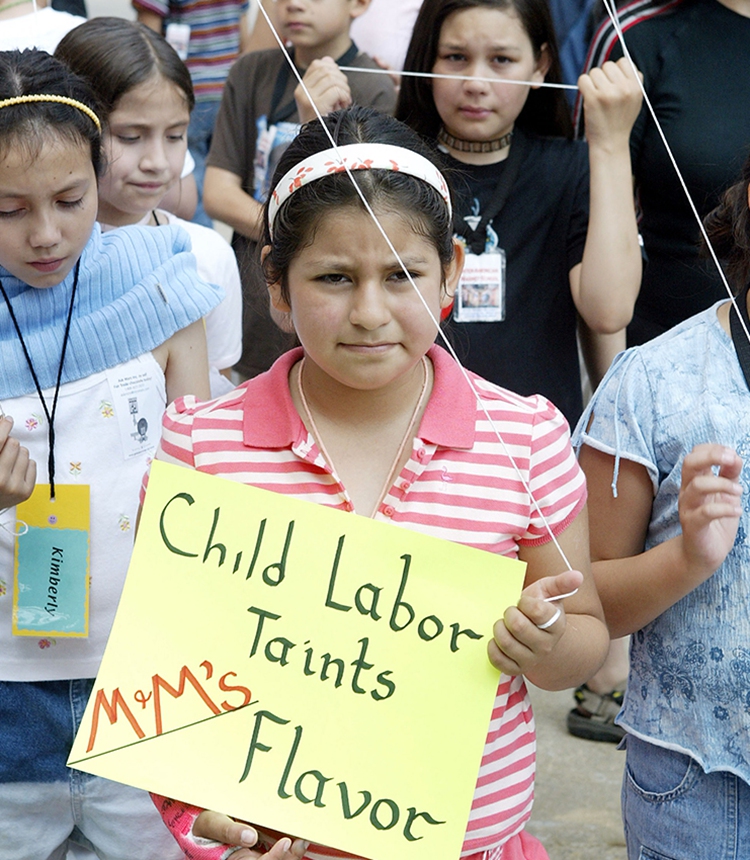
Children protest to demand M&M Mars candy company stop sourcing cocoa from suppliers using child labor in Chicago. Photo: AFP
The American Federation of Teachers (AFT), a professional union committed to ending child labor in the US,pointed out that agricultural work is demanding and dangerous for children, with frequent exposure to pesticides greatly increasing their risk of developing cancer. AFT cited a report by the US Government Accountability Office exposing that 100,000 child farmworkers are injured on the job annually and that children account for 20 percent of farming fatalities.The Global Times found that although the US has introduced a series of laws and regulations that seem to prohibit children from working in most industries, and guarantee their right to an education, these rules do not apply to agricultural work-minors can work an unlimited number of hours outside of school hours "because of outdated exemptions based upon an agrarian society largely left in the past.
"Today's farmworker children are largely migrant workers who deserve the same protection as other youth working in less dangerous occupations," the AFT appealed on its website.
But the reality is harsh. "In the past, many Chinese Americans worked as child labor and they are now out of the rack with their own efforts, but that does not mean this phenomenon has improved more significantly in American society,"Tang said, noting that he has always heard other suppliers talking about the saddening experiences of young children on farms or in food processing plants.
"Most of them, like us, are descendants of immigrants or people of color, but absurdly, they still can't have a normal childhood like most of our kids in the 21st century," Tang sighed.
Increasingly insidious
Nowadays, in the face of legal restraints and pressure from the public, the long-standing labor problems in the US have morphed into more insidious forms, such as workplace discrimination based on race and gender, observers told the Global Times.
Although the US has passed Affirmative Action laws to decrease discrimination of particular groups based on their gender, race, sexuality, creed, or nationality, invisible discrimination still widely exists in the US, "for example, similar work with different pay for different races or genders, the use of child labor - especially among illegal migrants, or unfair employment," Zhu said.
With a high level of economization in the US, the "glass ceiling" in certain fields is hard to break. Few minorities are found working in the transport and the logistic industries, which are usually dominated by white citizens and migrants originating from Northern Ireland, Zhu noted.
Another example is that financiers and bankers are usually White. Other races have a much harder time climbing the same corporate ladder, said Zhu.
Contrary to the image of a "model minority" with a good income, many Chinese Americans currently face increasingly unfavorable work environments with more subtle forced labor and bullying, observers pointed out.
"In the eyes of their white leaders, the Chinese always grin and bear it, so exploiting them doesn't carry much risk of recrimination," Tang said.
"Although Biden signed executive order to combat racial discrimination against Asian Americans after taking office, currently we have not seen any concrete initiatives implemented, many of them are still just empty words," he added.
Racial discrimination at the workplace escalated during the COVID-19 pandemic, having made some non-Caucasian employees to lose their jobs. In Kansas, an Asian American woman, Nina Nguyen, said her former employer "forced her to distance herself from her white coworkers" at the beginning of the pandemic. Worse still, Nguyen said she was later fired for complaining about it, US media ABC7 reported in May 2020.
Now, as the Biden administration promotes mass vaccination, "people of other races may be later than the white majority in getting inoculated, which may create difficulties in finding jobs," Zhu added.
Of the eight fundamental conventions of the ILO, the US has ratified only two, making it one of the countries that have ratified the least in number.
The US' misdeeds on labor rights are not at all novel to economic and human rights scholars, who told the Global Times that labor exploitation, including forced labor, are inevitable in the US-led Western capitalist countries, "as Karl Marx said, 'capital comes dripping from head to toe, from every pore, with blood and dirt,'" said Li.
"Taking a look at the history of the US, its development was based on selling slaves and forced labor," Li told the Global Times. "Therefore, though the US now always barks at other countries, it actually has no standing in terms of labor issues."
